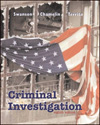 |  Criminal Investigation, 8/e Charles R. Swanson,
University of Georgia
Neil C. Chamelin,
Assistant State Attorney, Second Judicial Circuit
Leonard Territo,
University of South Florida- Tampa
Student Center
Contents:Chapter 1: The Evolution of Criminal Investigation and Criminalistics
Chapter 2: Investigators, the Investigative Process, and the Crime Scene
Chapter 3: Physical Evidence
Chapter 4: Interviewing and Interrogation
Chapter 5: Field Notes and Investigative Reporting
Chapter 6: The Follow-Up Investigation
Chapter 7: The Crime Laboratory
Chapter 8: Investigative Resources
Chapter 9: Injury and Death Investigations
Chapter 10: Sex-Related Offenses
Chapter 11: Crimes against Children
Chapter 12: Robbery
Chapter 13: Burglary
Chapter 14: Larceny and Fraud
Chapter 15: Vehicle Thefts and Related Offenses
Chapter 16: Computer Crime
Chapter 17: Agriculture, Wildlife, and Environmental Crimes
Chapter 18: Arson and Explosives Investigations
Chapter 19: Recognition, Control, and Investigation of Drug Abuse
Chapter 20: Terrorism
Chapter 21: The Investigator and the Legal System
|


 2002 McGraw-Hill Higher Education
2002 McGraw-Hill Higher Education